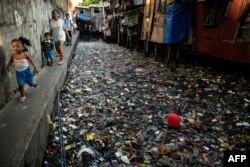The World Health Organization says levels of plastic in drinking water present a low risk to health, but need more research.
On Thursday, the WHO released a report on microplastics, particles smaller than five millimeters.
Bruce Gordon is the WHO’s coordinator for water, sanitation and hygiene. He said one of the main findings of the report is: “If you are a consumer drinking bottled water or tap water, you shouldn’t necessarily be concerned.”
However, Gordon said that the available information is “weak” and that more research is needed. He also urged a greater effort to reduce plastic pollution.
Andrew Mayes teaches chemistry at Britain’s University of East Anglia. He was not part of the WHO study. He said that microplastics did not appear to be a health worry for now.
But he added that stronger measures are needed to reduce plastic waste.
“We know that these types of materials cause stress to small organisms,” he said. “They could be doing a lot of damage in unseen ways.”
Health concerns center on smaller particles that get into drinking water and into human digestive systems.
A study supported by the Word Wildlife Fund and released in June said that plastic is widespread throughout the environment. It estimated that people may be eating or drinking as much as five grams of plastic each week. That is equal to the amount of plastic in a credit card.
Plastics are everywhere
The study found that plastics exist throughout the environment and have been found in sea water, freshwater, food and drinking water.
Possible risks from microplastics come from small particles, chemicals and microorganisms that stick to plastic materials.
Gordon said that the WHO would continue to study levels of microplastics in water. However, he said that higher importance is given to proven risks in drinking water such as bacteria that cause typhoid and cholera.
The report notes that microorganisms are the biggest threat to healthy drinking water. For example, research blames 485,000 deaths in 2016 on drinking water infected with microbes.
“These are the things that cause immediate illness and can kill millions of people,” Gordon said.
I’m Mario Ritter Jr.
Mario Ritter Jr. adapted story for VOA Learning English from AP and Reuters reports with additional information from the WHO report. Caty Weaver was the editor.
________________________________________________________________
Words in This Story
sanitation –n. the process of keeping places free of infection, dirt and disease by removing waste
hygiene –n. things that people do to keep themselves clean in order to maintain good health
consumer –n. someone or some group who buys goods and services
tap –n. a device that controls the flow of water or other liquids
absorb –v. to take in some liquid
priority –n. something that is more important than other things
We want to hear from you. Write to us in the Comments section, and visit our Facebook page.









